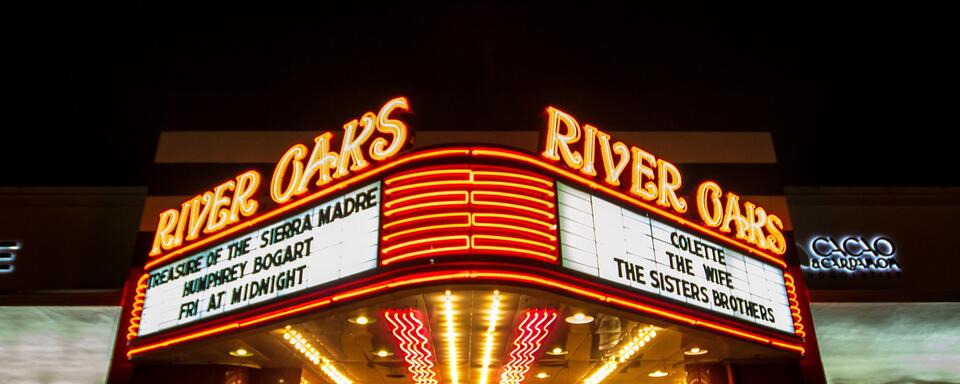
Truth and Cinema
Guest post by Steven DeLay
The River Oaks Theatre stands at 2009 West Gray St on the eastern periphery of its namesake’s neighborhood, one whose palatial mansions are among the city of Houston’s wealthiest and most exclusive, and home to prominent residents like Ted Cruz and Joel Osteen. The building’s surrounding storefronts are unremarkable, its high-end shopping center indistinguishable from any of the countless strip malls for which the city’s suburban sprawl has become so notorious. Lying just beyond the outstretched shadows cast by the urban ridgeline of the downtown skyscrapers that loom visibly two miles to the west and rises up like a desert mirage from the potholed concrete streets, the theatre itself belongs to an otherwise bygone Texas era. Opened in 1939, the cinematic art house, which retains its original Art Deco design characteristic of the early-twentieth century American architecture in vogue at the time of its construction, is now surrounded by an array of boutique clothing stores and gaudy jewelry shops, as well as the obligatory assortment of chain stores. By Houston standards even, the congested intersection of Gray and Sheperd just feet from the theatre is a particularly decadent, shallow commonplace—until the location on the Gray side closed in 2020, two separate Starbucks had stood directly across from one another at the same intersection. Of all places, it was here, in 2011, that I found myself seeing for the first time Terrence Malick’s The Tree of Life. I did not know the film would contain a number of scenes featuring shots of the very downtown landscape just miles from where I was watching it. Having recently moved from my home state of California, all I had known was that I was missing the ocean and the mountains, and that I was experiencing a thirst for a sip of visual beauty amid an asphalt jungle. Going to The River Oaks to see Malick promised to deliver it.
It is no overstatement to say that viewing Malick’s newest film that evening changed my life. I remember emerging from the air-conditioned confines of the theatre into the muggy night overwhelmed with emotion, hardly able to contain what could only be described as a sense of ecstasy and euphoria. I felt there was so much to say about what I had just witnessed, but I didn’t yet have the words to express what it was I was thinking. It was then that I first experienced the reaction anyone who admires Malick’s films at some point encounters. My girlfriend at the time, who had fallen asleep halfway through the screening, turned to me before I could get a word out. “Boring,” she said shrugging. It is not as if Malick’s films require a defense, much less from me. But I did feel like it would be worthwhile to one day try to say something philosophically useful about why they possess the great merit I believe they do, and what those who happen to disagree are overlooking. The seed was planted, though it would take a number of years to sprout.
For a decade since then, my own philosophical itinerary, both intellectually and geographically, has been punctuated along the way by the release of Malick’s newest offering. Right before leaving Houston to complete my doctoral studies at Oxford, my fiancée (different woman) and I saw To the Wonder at The River Oaks, a stunning cinematic piece of work that felt especially personally germane to us, given the prominent way in which Paris figures in it. (Prior to seeing it, we already had imagined ourselves eventually taking the Chunnel for an excursion to Mont St Michel). A few years later, as we prepared to leave Oxford, Knight of Cups appeared, a work that once again immediately resonated with me personally, inasmuch as it is a film that wrestles with the challenges that come with seeking and preserving one’s creative integrity in the face of institutional forces that threaten to stifle it. Unlike many viewers who found the film inscrutable and tedious, for me, Rick’s spiritual odyssey was inspiring, a quest that spoke directly to my own circumstances as a graduate student who at the time was attempting to find a way to produce academic work that would still somehow retain the original wonder and purity of heart that had led me to pursue philosophy in the first place. When Song to Song appeared in 2017, by then I had returned to Houston. The film’s spiritual deconstruction of youthful excess and debauchery, told through the story of an Austin love triangle, reminded me why I was glad to have left behind the Millennial world of cafes, bars, and music festivals that had once dazzled me in my twenties. By the time Malick’s most recent film, A Hidden Life, was released in 2019, we were living in Winston-Salem, and his films had ceased serving as periodic escapes from the mundane, and had instead become works of art whose exploration of the human experience deeply influenced my own philosophical vocation and vision as a phenomenologist. When the movie was over, I remember stepping onto the street, and before I could say anything, my wife saying, “You should write something about Malick.” Published this year in February, Life Above the Clouds: Philosophy in the Films of Terrence Malick is the result, a work that has been a decade in the making of thinking about Malick.
Though it is difficult to specify how precisely they do so, Malick’s films exhibit a deeply philosophical sensibility. This is hardly surprising, given Malick’s own experience having studied philosophy at Harvard and Oxford, culminating with his translating Heidegger before turning to a career in film. There is a danger, of course, that one might falsify what a film communicates by imposing a philosophical interpretation the film itself does not sustain. Malick’s films, in which characters sometimes quote directly from Kierkegaard or allude to Milton and Dostoevsky, can easily lend themselves to this mistake. But one respect in which I am sure that it is correct to treat Malick’s films philosophically concerns the way that they help us clarify the relationship between the arts generally and philosophy. Here again, this admittedly may appear to take things in the wrong direction. After all, on a standard reading of Plato, the arts are anathema to philosophy. Whereas philosophy pursues truth, which resides in the realm of the invisible Forms, the arts themselves, particularly mimetic arts such as painting, remain beholden to the visible world. At best, they give us copies of reality, for what they depict remains a shadow of it. And for this reason, they cannot be said to be works of truth, at least not the sorts of truth that should occupy philosophy.
This Platonic worry arises quite clearly in the specific case of cinema, since its very medium of expression is the image. How can images of the world reveal anything that is not already experienced by us in everyday experience? And if they can do so, in what respect is their truthfulness genuinely valuable?
The Hegelian answer, of course, is that art (including good artistic cinema) reveals truths about the society to which it belongs. It does not merely reflect or repeat a culture’s surface appearances, but rather serves as a mode of critique, by revealing things about that society’s subconscious understanding that would otherwise remain undisclosed or inaccessible. This way of viewing cinema has the virtue, at least, of attempting to justify art’s relation to truth. The trouble with it, however, is that the truth it claims cinema is capable of disclosing is such that the medium of art itself becomes subordinate to philosophy, which itself is said to possess the conceptual means for best expressing what art can only intimate. Rather than locating the value of art’s truthfulness as inherent to the work itself, art becomes an instrumental vehicle by which the truth it discloses can in turn be expressed more fully and properly by other means.
The idea that whatever the truthfulness of art is said to consist in can be more adequately expressed by other means is one that Malick’s cinema contradicts. Malick’s films disclose truths about the world and the human experience—truths above all, I would argue, about God—that can only be adequately shown in the “poetic image” of cinema. At stake in Malick’s films are non-discursive truths, truths that cannot be paraphrased in verbal articulation. They are, if you like, ineffable or unsayable truths, truths we can see, but cannot articulate. To be sure, as its history attests, film can be pernicious. Just as Plato worried, it can like other art forms seduce us into enjoying and affirming what is corrupting or false. And even if someone influenced by Hegel’s aesthetic theory is right that film has the power to unmask implicit beliefs and assumptions about our society’s ideology that would otherwise go unidentified and unquestioned, it remains the case that too often, whether by design or not, film has served as a form of social-engineering. When audiences go to see a movie (commercial films obviously, but even art film) for what they think is designed to be mere entertainment, they are oblivious to the way in which what they watch powerfully shapes their opinions and attitudes. In this respect, Plato’s allegory of the cave holds water. Entering the darkened cinema to view the projected images on the screen is akin to those who sat transfixed by the shadows on the cave’s wall. In short, audiences end up being manipulated by an ideological statement they fail to recognize is one.
Part of what makes Malick’s films so unique, in my opinion, is that they ultimately bracket the worldly concerns that other films, and the philosophical frameworks suited to analyzing them, traffic in. Malick’s works encourage us to see beyond the everyday political and economic world. They take us beyond all that, to a place where we confront a depth of reality whose dimension outstrips these worldly conditions, as well as their illusions. In turn, if what they show us about the human experience remains somehow ineffable or unsayable, this is because they are spiritual works of transcendence, whose artistic beauty stir us to moral and ethical reflection about what it is to be human. In viewing his films over the years, for me, this has meant being reminded of what it is to be a human being created in the image of God, and what it looks like to try to live a life emulating Christ.
In 2021, The River Oaks Theatre was closed. In a neighborhood flush with money, for a time, it sadly appeared that a place which had been a refuge for truth, an oasis for beauty among an otherwise inhospitable urban wasteland, would be lost permanently. Then last year, following a campaign supported by directors with Houston roots such as Richard Linklater and Wes Anderson, it was announced the theatre would indeed return, opening again for audiences. This good news is particularly timely for admirers of Malick. As it happens, he currently is working away on editing what will be his next release, The Way of the Wind which will be about the life of Christ. Although the film has yet to receive a release date, and Malick’s editing process can lead to long waits, when the time comes, and the film does appear, The River Oaks will still be there to show it. I just may make the trip to see it.
Steven DeLay is Research Fellow at the Global Center for Advanced Studies. His many books include Everything; Faint Not: Twelve Brief Meditations on the Word of God; In the Spirit: A Phenomenology of Faith; Before God: Exercises in Subjectivity; and Phenomenology in France: A Philosophical and Theological Introduction.

